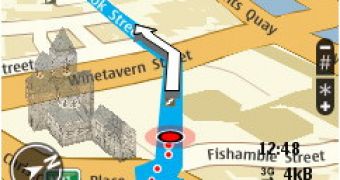Finnish mobile phone maker Nokia announced recently the release of a new version of its Ovi Maps, meant to bring far more features than previous iterations, like syncing between mobile devices and the web and the possibility to add personal location-based content. In addition, says the company, the one-size-fits-all static bitmap maps that can be usually found on the web will be replaced with dynamic vector-graphic maps that can enhance the user experience both on the web and on the mobile phone.
In addition to enhancing the Ovi Maps, Nokia also announced that it had released the Ovi Maps Player API, which is expected to offer the possibility to embed the rich and dynamic Ovi Maps experience into any website by using JavaScript. This move, the company says, is meant to open the Ovi Maps to third parties, providing them with a “deeper level of integration, sharing and collaboration with their audiences.” The Ovi Maps included in different sites will also allow for personalization with user content while and provide the possibility to be synchronized with compatible handsets.
The latest version of Ovi Maps comes to mobile phones with high-resolution satellite and terrain maps, offered both in 2D and 3D views, 3D landmarks for over 200 cities, rotation, tilting, night view, fly-overs and fly-throughs. In addition, it also includes enriched POI information, a weather service, Walk – pedestrian navigation, and Drive – car navigation with real-time traffic information.
“Ovi Maps is evolving from a consumer service to a live and dynamic platform for location-based services and content shared between the mobile device and the web. By adding this richer dimension to Ovi Maps we are both creating new experiences for consumers and new opportunities for developers,” says Michael Halbherr, vice president, Social Location Services at Nokia.
The Ovi Maps Player API, he adds, provides an easy-to-use map browser that has been developed based on simple web technologies and which can be embedded into any website. According to him, this is the first time when Nokia allows developers to access its unique contextual assets, including location, for the creation of mobile applications meant to redefine the mobile experience.
“We are thrilled to be one of the first companies to be working with the Ovi Maps Player API,” says Stephen Palmer, president, Lonely Planet, EMEA. “This is a transformational partnership, which makes Lonely Planet content available regardless of time or place. Working with this new platform adds value to the Lonely Planet offering and together with Nokia we will help more travellers connect profoundly with their world, everyday.”

 14 DAY TRIAL //
14 DAY TRIAL //